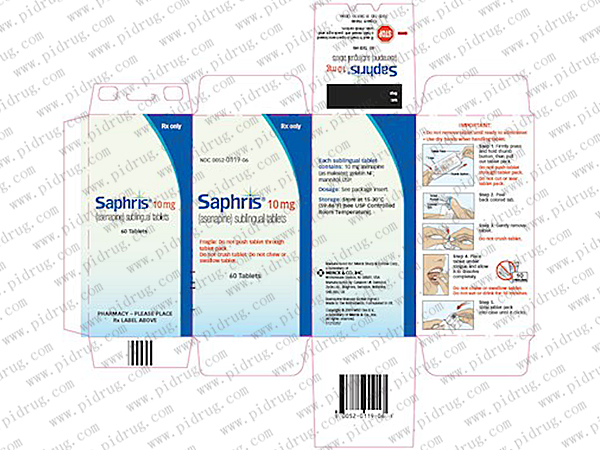Asenapine, sold under the trade names Saphris and Sycrest among others, is an atypical antipsychotic medication used to treat schizophrenia and acute mania associated with bipolar disorder.
It was chemically derived via altering the chemical structure of the tetracyclic (atypical) antidepressant, mianserin.[5]
Medical uses
Asenapine has been approved by the FDA for the acute treatment of adults with schizophrenia and acute treatment of manic or mixed episodes associated with bipolar Idisorder with or without psychotic features in adults.[6] In Australia asenapine's approved (and also listed on the PBS) indications include the following:[7]
§ Schizophrenia
§ Treatment, for up to 6 months, of an episode of acute mania or mixed episodes associated with bipolar I disorder
§ Maintenance treatment, as monotherapy, of bipolar I disorder
In the European Union and the UK asenapine is only licensed for use as a treatment for acute mania in bipolar I disorder.[3][4]
Absorbed readily if administered sublingually, asenapine is poorly absorbed when swallowed.[8]
Schizophrenia
There is only weak evidence supporting the use of Asenapine for treating schizophrenia, making it hard to recommend.[9]
Acute mania
As for its efficacy in the treatment of acute mania, a recent meta-analysis showed that it produces comparatively small improvements in manic symptoms in patients with acute mania and mixed episodes than most other antipsychotic drugs (with the exception of ziprasidone) such as risperidone and olanzapine. Drop-out rates (in clinical trials) were also unusually high with asenapine.[10] According to a post-hoc analysis of two 3-week clinical trials it may possess some antidepressant effects in patients with acute mania or mixed episodes.[11]
Adverse effects
Adverse effect incidence[1][2][3][4]
Note: The discussion below these lists provides some more context into the frequency and severity of these adverse effects.
Very common (>10% incidence) adverse effects include:
§ Somnolence
Common (1-10% incidence) adverse effects include:
§ Weight gain
§ Increased appetite
§ Extrapyramidal side effects (EPS; such as dystonia, akathisia, dyskinesia, muscle rigidity, parkinsonism)
§ Sedation
§ Dizziness
§ Dysgeusia
§ Oral hypoaesthesia
§ Increased alanine aminotransferase
§ Fatigue
Uncommon (0.1-1% incidence) adverse effects include:
§ Hyperglycaemia — elevated blood glucose (sugar)
§ Syncope
§ Seizure
§ Dysarthria
§ Sinus bradycardia
§ Bundle branch block
§ QTc interval prolongation (has a relatively low risk for causing QTc interval prolongation.[13][14])
§ Sinus tachycardia
§ Orthostatic hypotension
§ Hypotension
§ Swollen tongue
§ Dysphagia (difficulty swallowing)
§ Glossodynia
§ Oral paraesthesia
Rare (0.01-0.1% incidence) adverse effects include:
§ Neuroleptic malignant syndrome (Combination of fever, muscle stiffness, faster breathing, sweating, reduced consciousness, and sudden change in blood pressure and heart rate)
§ Tardive dyskinesia
§ Speech disturbance
§ Rhabdomyolysis
§ Angioedema
§ Blood dyscrasias such as agranulocytosis, leukopenia and neutropenia
§ Accommodation disorder[clarification needed]
§ Pulmonary embolism
§ Gynaecomastia
§ Galactorrhoea
Unknown incidence adverse effects
§ Allergic reaction
§ Restless legs syndrome
§ Nausea
§ Oral mucosal lesions (ulcerations, blistering and inflammation)
§ Salivary hypersecretion
§ Hyperprolactinaemia
Asenapine seems to have a relatively low weight gain liability for an atypical antipsychotic (which are notorious for their metabolic side effects) and according to a recent meta-analysis it produces significantly less weight gain (SMD [standard mean difference in weight gained in those on placebo vs. active drug]: 0.23; 95% CI: 0.07-0.39) than, paliperidone (SMD: 0.38; 95% CI: 0.27-0.48), risperidone (SMD: 0.42; 95% CI: 0.33-0.50), quetiapine (SMD: 0.43; 95% CI: 0.34-0.53), sertindole (SMD: 0.53; 95% CI: 0.38-0.68), chlorpromazine (SMD: 0.55; 95% CI: 0.34-0.76), iloperidone (SMD: 0.62; 95% CI: 0.49-0.74), clozapine (SMD: 0.65; 95% CI: 0.31-0.99), zotepine (SMD: 0.71; 95% CI: 0.47-0.96) and olanzapine (SMD: 0.74; 95% CI: 0.67-0.81) and approximately (that is, no statistically significant difference at the p=0.05 level) as much as weight gain as aripiprazole (SMD: 0.17; 95% CI: 0.05-0.28), lurasidone (SMD: 0.10; 95% CI: –0.02-0.21), amisulpride (SMD: 0.20; 95% CI: 0.05-0.35), haloperidol (SMD: 0.09; 95% CI: 0.00-0.17) and ziprasidone (SMD: 0.10; 95% CI: –0.02-0.22).[15] Its potential for elevating plasma prolactin levels seems relatively limited too according to this meta-analysis.[15] This meta-analysis also found that asenapine has approximately the same odds ratio (3.28; 95% CI: 1.37-6.69) for causing sedation [compared to placebo-treated patients] as olanzapine (3.34; 95% CI: 2.46-4.50]) and haloperidol (2.76; 95% CI: 2.04-3.66) and a higher odds ratio (although not significantly) for sedation than aripiprazole (1.84; 95% CI: 1.05-3.05), paliperidone (1.40; 95% CI: 0.85-2.19) and amisulpride (1.42; 95% CI: 0.72 to 2.51) to name a few and is hence a mild-moderately sedating antipsychotic.[15] Being a second-generation (atypical) antipsychotic its liability for causing extrapyramidal side effect is comparatively low compared to first-generation antipsychotics such as haloperidol as is supported by the aforementioned meta-analysis (although this meta-analysis did reveal it had a relatively high EPS liability for an atypical antipsychotic drug).[15]


